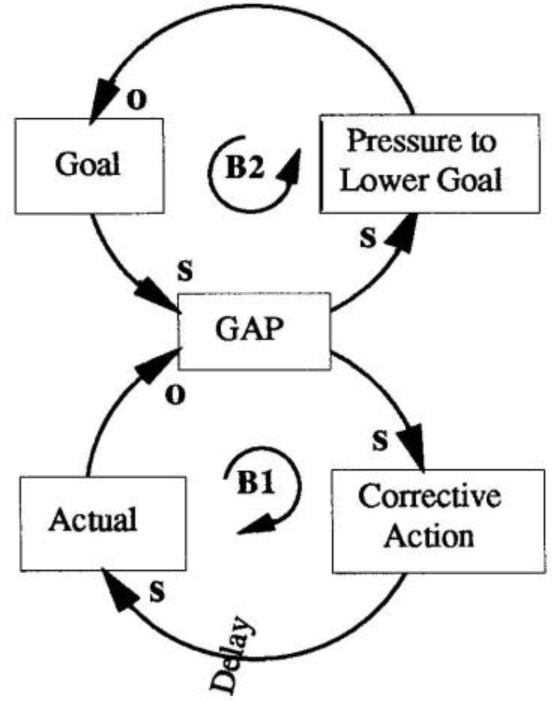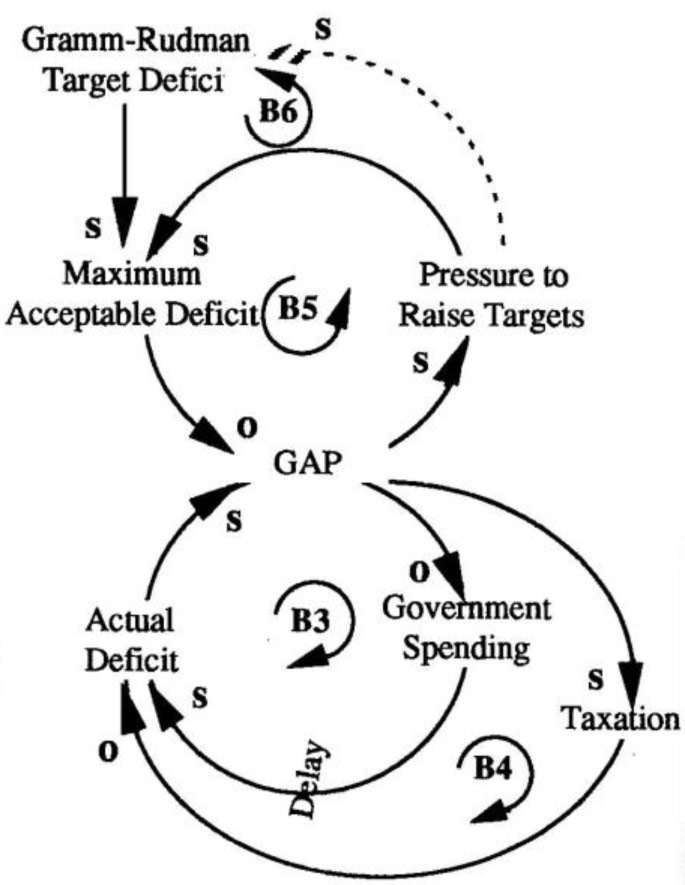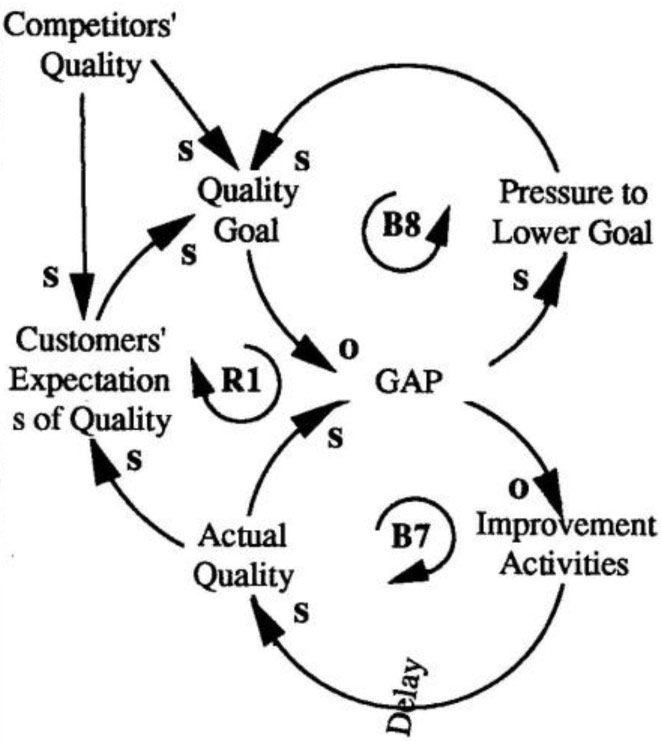It’s becoming an old story in the systems thinking field: If you drop a frog into a pot of boiling water, he will immediately hop out and save himself. But, if you put him in a pot of lukewarm water and slowly turn up the heat, something different happens. The frog swims around contentedly for a while, even enjoying the balmy water. As the temperature rises, he becomes more groggy and lethargic until finally he dies.
The frog may not have known it, but he was a victim of a drifting goals scenario. Drifting goals is a structure that leads to poorer and poorer performance and/or lower and lower expectations (or in the frog’s case, higher and higher temperature). In a company setting, this structure may take the form of slipped delivery schedules, where a once-intolerable eight week delivery delay becomes the accepted goal, or lower quality standards, as everyone focuses on decreasing backlogs and delivery delays by just getting the product “out the door.”
Drifting Goals Template

In a Drifting Goals archetype, a gap between the goal and current reality can be resolved by taking corrective action (BI) or lowering the goal (B2).
Making adjustments to initial goals is not inherently wrong. Sticking to the original goal purely for its own sake is as misdirected as changing the goal at every whim. But distinguishing between legitimate goal adjustments and the Drifting Goals structure can be very difficult — it is easy to rationalize adjustments as “needed corrections.”
The Boiled Frog Structure
The archetype works in the following manner (see “Drifting Goals Template” diagram). There is a certain goal — implicit or explicit — which is compared to the current state of affairs. If a gap persists, corrective actions are taken to improve the current state and bring it in line with the goal. This forms the basic balancing loop (B1) at the heart of any system that strives for equilibrium. A delay between corrective action and actual state represents the fact that results may take from minutes to years to materialize, depending on the specific situation.
Of course, there is more than one way to close the gap. In the Drifting Goals archetype, a second balancing loop is driven by pressure to lower the goal. As the gap increases (or persists over a period of time), the pressure to lower the goal increases. If the pressure is high and persistent, the goal may be lowered, thereby decreasing the gap (loop B2).
The critical difference between the two loops is that lowering the goal immediately closes the gap, whereas corrective actions usually take time.
In the frog’s case, the goal is a desired body temperature. If the gap between this desired temperature and the water temperature is large, the frog will immediately take a corrective action and jump out of the water. But, if the temperature increases gradually, the gap between his ideal temperature and the water temperature widens slowly. As this happens, the frog’s perceived desired temperature may gradually drift higher. This closes the gap between desired and actual temperature, negating the need to take corrective action until it is too late.
The reason drifting goals is labeled the “boiled frog” syndrome is that goals, like the frog’s ideal temperature, tend to drift slowly and usually go unnoticed. Similar to the frog that doesn’t recognize a gradual rise in temperature, organizations are often unalarmed by deteriorating performance if it occurs over a long period of time.
Budget Deficits, Drifting Goals
The federal budget deficit is a good example of the Drifting Goals archetype at work (see “Budget Deficit” diagram). If there is a gap between the previously stated acceptable deficit level and the actual deficit, it can be closed by either reducing government spending (B3) or increasing tax revenues (B4). Bipartisan compromises, however, have usually resulted in increased government spending, mixed results in terms of taxes, and, consequently, higher deficits. The rising deficits created an intolerable gap between the actual and stated maximum acceptable deficit, creating pressure to raise deficit targets, and eventually resulting in higher maximum acceptable deficits (B5).
The Gramm-Rudman-Hollings bill (GRH) was seen as the answer to the growing budget deficit. By making deficit reductions a law, it was intended to force bipartisan cooperation to eliminate deficit spending. If GRH target numbers are not met, mandatory cuts go into effect, indiscriminately cutting billions of dollars from federal government programs and services. The GRH targets were meant to set a standard that lay outside of the current deficit reinforcing system — a standard that would not succumb to the internal pressures.
Budget Deficit

Rudman’s new proposal would reintroduce GRH targets into the very drifting goals situation it was intended to change (B6).
In an article in Barron’s magazine (“Rudman on Gramm-Rudman” July 16, 1990), Senator Rudman reacted to pressures to lower the goal by suggesting that GRH targets may be changed as “long as they are accompanied by a major deficit reduction.” Rudman’s new proposal would reintroduce GRH targets into the very drifting goals archetype it was intended to change (B6).
Using the Archetype
Drifting performance figures usually are a quick clue that this dynamic is occurring and that real corrective actions necessary to meet the targets are not being taken. It may also mean current targets are being set more by past levels of performance than by some absolute standard (zero defects) or by something outside of the system (customer requirements).
The flipside is also true: a steady pattern of improvement can mean that the goal is continually being adjusted upwards. Total Quality (TQ), Kaizen, and other continuous improvement efforts are examples of the Drifting Goals structure being used in a positive manner to drive goals higher.
Quality Improvement

In a quality improvement scenario, the quality goal can be affected by competitors’ quality, customers’ expectations of quality, or internal pressures.
The “Quality Improvement” diagram provides a useful framework for applying the Drifting Goals structure to other organizational issues. The lower loop (B7) represents improvements while the upper loop (B8) represents ever-present pressures to lower the goal. TQ works well, in part, due to the reinforcing loop (RI): improvements in quality lead to higher customer expectations, raising the quality goal and increasing the gap. In a company committed to TQ, this gap leads to further quality improvements.
A critical aspect of evaluating a Drifting Goals scenario in an organization is to determine what drives the setting of the goal(s). In the “Quality Improvement” diagram, the Quality Goal can be affected by competitors’ quality, by customers’ expectations of quality, or by internal pressures. The relative strength of each potential influence will determine whether the quality will drift up, down, or oscillate. Goals located outside the system, like the original GRH targets, will be less susceptible to drifting goals pressures.
